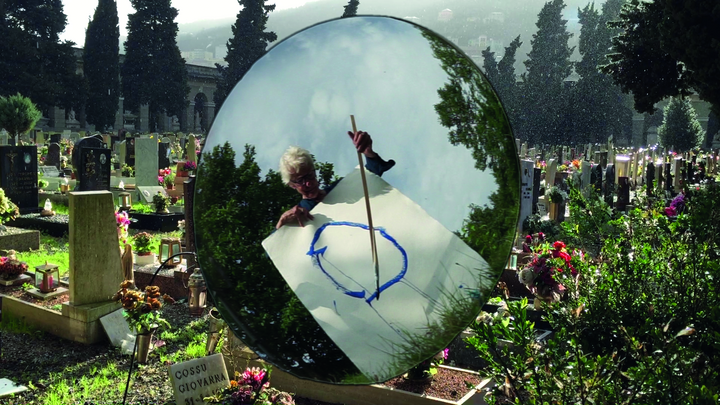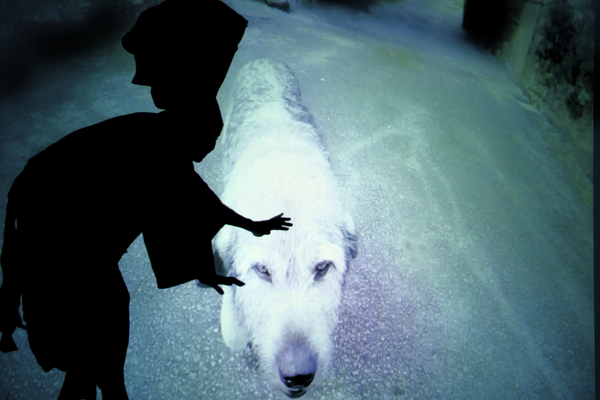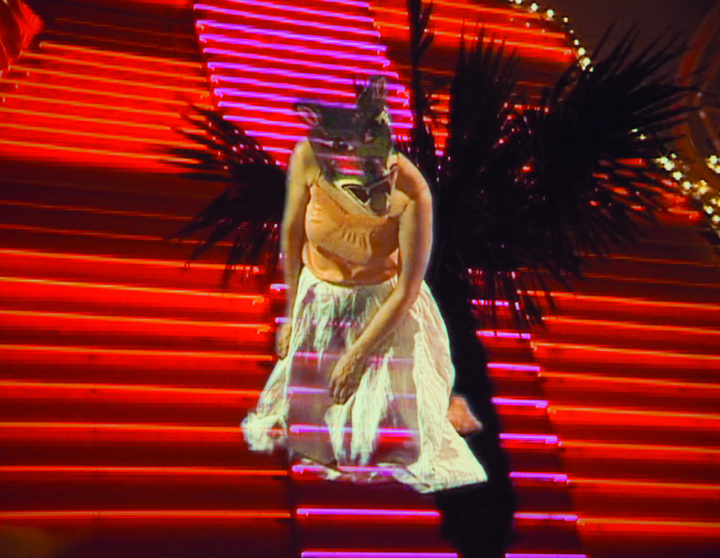#1:
Source: Paper Trail: (Re)viewing “Lines in the Sand” and Other Key Works of Joan Jonas
Highlights:
- Joan Jonas: Five Works, a retrospective at Queens Museum of Art in New York (2004)
- “This evolution parallels the challenge the artist herself faces as a maturing performer sustaining and expanding a practice in which she is both no longer capable of and less interested in predominantly foregrounding herself.”
- “Conceding each contesting view, however, leaves the matter of curatorial and exhibition approaches to work negotiating spatial and temporal modalities naggingly open-ended, which is precisely/imprecisely the point.”
- early themes of female imagery to more recent themes featuring world events (like the middle east) and the role of an artist in society
- “Her practice freely, though not easily, exchanges the subject/object coordinates securing viewer and performer position, shifting and conflating the viewer with the viewed as well as complicating tense frames in real- time and simultaneous performance, pre-recorded and closed-circuit video, and playback nesting.”
- “In his essay … describes Jonas’s work as an art of “‘acts’ in action,” implicating performer and viewer in a shared quest for “new vocabularies,” remaking “new stories from old.””
- her research:
- Jonas trained as a sculptor and began her groundbreaking work in video following her acquisition of a Sony Portapak in Japan in 1970.
- She brought to her practice a sculptural concern with space and form, a collage sensibility informed by early French and German cinema, especially silent films, and an eye studied in the illusionistic vistas of High Renaissance painting, a vantage specifically gendered feminine, Dave Hickey notes, by its “rapidly receding pictorial space, evoking both the prospect of heavenly Arcadia and the mystery of the ‘erotic other’. . . . [an] open picture plane . . . offering both a window into spiritual succor and the prospect of a ‘heavenly cunt’ (potta del cielo) to the beholder.”
- Travel gave her first-hand experience of the performance and ritual practices of other cultures – Japanese theatre, Chinese opera, Hopi dances, Mexican and Celtic folklore.
- It was the heyday of literary deconstruction and feminism’s first wave.
- Five Works analysed/described:
- An austere black dress and a man’s suit coat, both trimmed with rectangular mirrors, hang suspended from the ceiling beside a Peter Campus photograph of Jonas wearing the dress.
- A small monitor to the right screens her short film Wind (1968), shot with Campus, in which a couple in mirror-trimmed winter dress criss-cross a windswept Long Island beachside in rigid lockstep. Other players join them, forming geometric arrangements and performing everyday gestures (taking off and putting on coats) redolent of the task-oriented movement of Judson [dance theatre], though heightened by dislocation and an almost impertinent resolve to engage the opposing and dominating wind churning tide and shore. Emerging in the advent of post-minimalism, with artists reappraising the cool assurance of pure form, psychologizing a natural force, the wind, as a player in her performance extended the interplay of subject/object exchange underway in experimental dance (Cunningham, Brown, Judson) and process-oriented art (Serra, Smithson, Morris), anticipating as well future explorations of sacred spaces and ritual central to her mixed medley of live and media-interpolating performance.
- …Barbara Clausen notes the critical division generally made between the artist’s early material preoccupation with video and the later narrative–based fairy tale work.
- Projected onto a ceiling-hung screen, Songdelay (1973) is a group performance executed on the wasted lower Manhattan landscape, levelled and filled in preparation for the construction of the World Trade Center towers. The players, unremarkable in casual, mid-winter, gender-neutral clothing, hold wooden blocks in each hand, which they systematically clap overhead, punctuating spatial intervals with percussive strikes.
- These early works investigate perception-sonically, with the sound blocks in Songdelay, Jones Beach Piece (1970), and Delay, Delay (1972), and visually, with the mirrors in performances of Mirror Piece (1968-70, on view in gallery ten) and Mirror Check (1972) that capture fragments of the viewer in reflection and disrupt presumptions of specular dominion.
- Her preoccupation with perception, however, exceeds a purely formal or material concern. As an interface between external reality and the self, perception plays a constitutive role in identity and being.
- Rather than a synchronous process, hearing occurs in discrete intervals that are synthesized with memory to yield recognition, a time-lapse feint of simultaneous perception. In other words, there’s a delay between event and apprehension. It’s in and around the space of this delay that Jonas operates, the charged field she articulates.
- ..feminists advocated an expansive, potent feminine imaginary issuing from the female body, operating through and against rigid binary formulations of presence/absence, reason/emotion to refigure more fluid subject possibilities.
- Kristeva used the maternal body to figure her theory of the chora, a womblike enclosed space of semiotic or pre-verbal drives or “pulsions” eclipsed but not completely eradicated in the self once language was acquired. Jonas’s stake in this discourse is two-fold: first, as a performer, both artist and agent, she embodies the figurative tension of subject and object; and second, the space she defines and operates in is a choralike performative field of gesture, image, and sound.
- In 1972, Jonas created her “electronic sorceress” and alter ego, the TV persona and seductress Organic Honey, so named for a label on a jar of honey in the artist’s loft. She purchased a semi-transparent doll-face mask at a shop selling erotica and added a feathered headdress. In the guise of Organic Honey, Jonas wore a beaded, Jordan- almond green chiffon dress and high–heeled, ankle-strap shoes. Reiterating the feminine through the domestic, she filmed in her loft, creating within it a film set using props and objects from her family and tacking her drawings to the wall. Shooting videos she called films deftly imbued the work with the multiple yet distinct theoretical valences of two media: film, with its emphasis on the gaze and problematics of representation, and video, with its critical associations of narcissism. Jonas performed Organic Honeys Visual Telepathy, the phrase “visual telepathy” taken from a book on magic, incorporating prerecorded with real-time material shot by a camerawoman, another double, in a shared performance arena.
- The installation overlaps and displaces itself with content repetition and the presence in the gallery of the actual objects and drawings shown virtually on screen, and returned again in the reflected image of the large plate glass mirror set on the floor against the gallery wall. This multiple layering, including the real-time capture of the viewer in the mirror, works to resurrect the peripatetic, desynchronized, simultaneity of the original performances.
#2:
Sources:
Highlights:
- Early works from the late 1960s are shown alongside recent installations dealing with topical themes such as climate change and extinction.
- Hero to a generation of younger artists, Joan Jonas is a pioneer of performance and video who has pushed the boundaries of art for the last five decades.
- Jonas’ projects and experiments provided the foundation on which much video performance art would be based.
- Her influences also extended to conceptual art, theatre, performance art and other visual media.



#3:
Source: An article by Katherine Grosshans in Artweek issue from November 1975
Highlights:
- Covering Jonas’ performance of Native Dance in October 1975.
- “Native Dance was a non-narrative action collage of light, movement, shapes, objects and sound. Jonas and- two Seattle artists, Karen Helmerson and Chris ionic, created a continuity of images that they built from a series of separate but inter-reflective actions: fractured storytelling, door slamming, spontaneous gestures with objects and toys, bell ringing, belt slapping and bodies wearing mid-eastern shades as they crisscrossed the floor. These actions were punctuated by bursts of loud sound and music from two opposite set speakers, by Marlene Dietrich music and by short film segments reminiscent of Jonas’ videotapes of the vertical roll across the screen.”
- “What made the performance comprehensible were the recurrence of basic elements and the Interconnections and cross-references between separate actions.
- One element was the use of light and it’s correspondent negative – shadow. The television monitor was periodically a source of a bluish glow. Candlelight and uncovered electric bulbs were a centralized light source which, as it faded from the centre of the tube, cast on the opposite wall long, milky-edged shadows of all objects and movement. The film sequences, always set off separately as if designating a point of transition, were another source of projected light.
- Jonas developed the exploration of shape, both in movement and as static form, as an additional basic element. Several ten to twelve feet tall cones of heavy backdrop paper were constructed for the performance…The three performers were also evident as shapes when they appeared covered in the shadris, which allowed for no individual characteristics Their forms, vacillating between a definition of shape and shadow, were Indistinguishable as bodies . They became objects in movement.
- There was sound as an element in addition to light and form…Voices, yells, laughter and fragments of speech were interjected periodically. Doors slammed, a record player, and a television set was turned on to be heard but not seen. All these created an overlapping of sound much as the light sources, shadows and objects were overlapped.”
- “The most readily understood of these was the contrast established between the action directly seen and that which was visually inaccessible.”
- “Visual sensibility often became secondary to auditory, or even to intuition.”
- “Jonas began the performance by alternately sitting behind the monitor, speaking soundlessly to the video camera so that she was only visible as a silent image on the monitor, then standing up as she spoke audibly, but not long enough for her words to carry meaning. As she stood up her face was seen suddenly in colour and direct while her torso was visible only in black and white on the monitor. This jack-in-the-box intermixing of images focusing on the same object – Jonas herself – both emphasized the two-dimensionality of the video image and confirmed the contusion of directly perceived reality.”
- “Through the use of toys and children’s games, she called up various’ hazy, partially subconscious childhood images, normally unreconcilable with the present moment of conscious, admissible action.”
- “The sense one brings away from this performance is of a spiritual, almost ritualistic collage of meaning and actions.”
- “She points to the ‘behind the screen’ within ourselves which we cannot ‘see’ as she pushes us to coordinate all our senses and as she emphasizes the function of awareness, ever utilized and expanding. “
- “Understood in this way, Jonas appears to be moving away from the use of art as a tool …bringing it full circle again to-one of its original functions and meanings – as a sensory transmission of perceptual, perhaps spiritual experience from one mind to another, a ritualistic expression of both the evident realities of experience and the collage of indistinguishable/ uncontrollable aspects of the performance in which all participate.”
Source: Video Art: Expanded Forms by John G. Hanhardt
Highlights:
- “The performance artist, Joan Jonas created a series of videotapes, performances (Vertical Roll, 1972) and installations in the 1970s that were rooted in a conceptual and minimalist aesthetic and investigated the nature of image construction through time and repetition.”
- Self-reflective narratives
- “In recent years, she has constructed personal visionary fantasies in performances and videotapes that combine objects, props, painting, music, voice and movement to evoke images and emotions across media and materials.”
- ” In Jonas’s installations, videotapes and video imagery provide temporal elements as well as a cognitive focus that unites the works. “
#4:
Source: Interview – TateShots
Highlights:
- felt that performance was a language that she could develop
- makes models of the installation during preparing/developing the installation
- “I find the images as I work”
- L a Y e R i N g
- inspired by travel
- interest in rituals
- depicts her vision as clearly as possible through images and “some” words
- people should take time to experience it and to not rush into trying to understand it
#5:
Source: EAI profile
Highlights:
- From her seminal performance–based exercises of the 1970s to her later televisual narratives, Jonas’ elusive theatrical portrayal of female identity is a unique and intriguing inquiry.
- In works that examined space and perceptual phenomena, she merged elements of dance, modern theatre, the conventions of Japanese Noh and Kabuki theatre, and the visual arts. Jonas first began using video in performance in Organic Honey’s Visual Telepathy (1972), in which a live camera and monitor functioned as both a mirror and a masking device, a means of transforming and layering images, space and time.
- Her classic early works, including Vertical Roll (1972), explore the phenomenology of the video medium — its one-on-one directness and function as a mirror — to create a theatre of the self and the body.
- Jonas’ investigation of subjectivity and objectivity is articulated through an idiosyncratic, personal vocabulary of ritualized gesture and self-examination. Often performing in masks, veils, or costumes, Jonas uses disguise and masquerade to study the personal and cultural semiotics of female gesture and symbols. The layering of mirrors and mirrored images is one of her most powerful metaphorical devices. Among Jonas’ signature formal strategies are the manipulation of theatrical and video space, the use of drawing to add a rich density of texture and content, and objects that convey meaning as cultural icons, archetypes and symbols.
- Her elliptical, fragmented video narratives often merged such storytelling forms as fairy tales (Upsidedown and Backwards, 1980), science fiction (Double Lunar Dogs, 1984), legends (Volcano Saga, 1989), myths and dreams with topical and autobiographical references. Just as Jonas’ works of the 1970s exploited the rudimentary technological properties of video as conceptual devices, so these later works utilize sophisticated electronic techniques to achieve a multi–dimensional theatre that explores the fragmentation and loss of memory and identity in postmodern culture.
- …Jonas herself always appears as a performer, confronting the viewer in an enigmatic theatre of self-discovery.
#6:
Source: Between Art History and Media History: A Brief Introduction to Media Art
Highlights:
- …on video, the most memorable work, however, was done by Joan Jonas during the 1970s, blending performance, dance and a playful engagement with the camera and its observing function in a way that made sense both as a live performance and as a subsequent installation and videotape.
- The mirror as a narcissist object of self–contemplation but also of a distorted self–perception is just as present in Joan Jonas’ work as the stylistic device of reflection.
#7:
Source: VDB profile
Highlights:
- Joan Jonas studied sculpture and art history at Columbia University and Mount Holyoke College, and dance with Tricia Brown at the Boston Museum School.
#8:
Source: Video Beginnings: The Early Show: Video from 1969-1979
#9:
Sources:
#10:
Source: New Yorker article
#11:
Source: Performing Histories: Why the Point Is Not to Make a Point…
Highlights:
- Mangolte’s training as a cinematographer, her reduced interference with the action and her intuitive approach toward her subjects proved especially relevant for the camera work in Joan Jonas’s seminal video-performance Organic Honey’s Visual Telepathy (1972) and Organic Honey’s Vertical Roll (1973), as well as for the majority of Jonas’s performances that Mangolte filmed until 1978. Mangolte, with her Sony Port-a-Pak video camera positioned on her shoulder and/or on a tripod, followed Jonas’s movements precisely, creating a steady stream of close-up images of the dynamic and dazzling character Organic Honey’s interactions with various props, costumes, mirrors, monitors and other recording devices. Mangolte supplied a consistent visual frame for Jonas’s monotonous repetition of singular gestural movements – such as her rhythmic knocking of a mirror with a spoon? her impromptu live-drawing sequences or her constant costume changes. Jonas’s presence and actions, and the simultaneous playback on various screens and monitors dispersed in an ‘all over‘-like treatment of the performance space, created a scenario that Douglas Crimp described as an effect of de-synchronisation. The body had lost its position at the centre; it was dispersed and caught between the different apparatuses merging the acts of recording, reproducing and perceiving.
#12:
Source: Joan Jonas: Images and sounds in the material of time
#13:
Source: Jonas’ “Basic CV”
